Great Lakes - PGDM & PGPM Admissions 2026
Globally Recognized by AACSB (US) & AMBA (UK) | 17.8 LPA Avg. CTC for PGPM 2025
For CAT 2025 aspirants, consistent practice plays a key role in achieving a high percentile. On Day 36 of our 60-day CAT 2025 preparation plan, we bring you CAT Mock Test Series 9 to help assess progress, sharpen accuracy, and reinforce core concepts. This CAT sample paper includes section-wise practice questions from Quantitative Aptitude, DILR, and VARC, with detailed solutions for better clarity. The CAT 2025 exam features 7 questions in Part-A, 10 in Part-B, and 10 in Part-C, including 1 RC and error detection exercises.
The CAT 2025 results are expected to be announced in the first week of January 2026, based on trends from previous years. Candidates will be able to check their scores and download the scorecard from iimcat.ac.in.
This Story also Contains
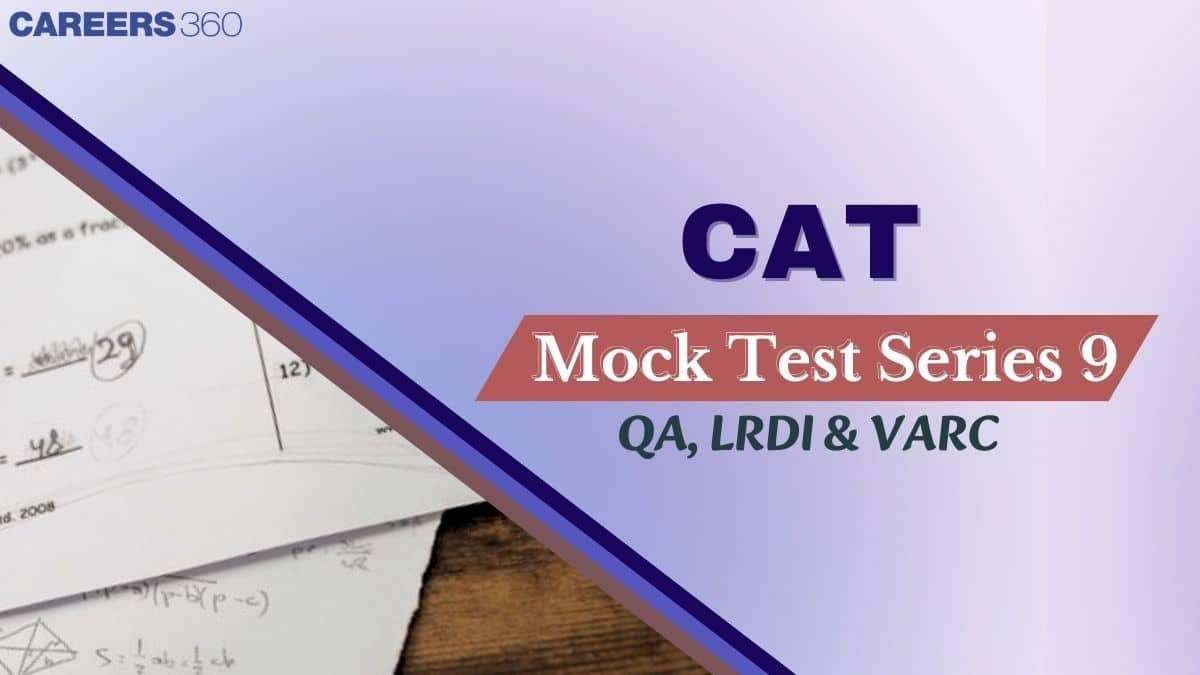
CAT Mock Test Part-A serves as a crucial practice segment designed to simulate the actual CAT exam environment. It helps aspirants evaluate their preparation level, improve time management, and understand question patterns. By attempting Part A regularly, candidates can identify strengths, pinpoint weaknesses, and refine strategies to boost overall performance in the real CAT exam.
CAT previous year question 1. The number of ways of arranging 8 persons in a row is
(permutation and combination previous year questions)
(a) 8! (b) 7! (c) 8 (d) 4
Ans: (a)
The number of ways of arranging n persons in a row is n!
CAT previous year question 2. How many 4-digit odd numbers can be formed using [0, 2, 3, 5] such that all digits to be used altogether?
(a) 256 (b) 12 (c) 8 (d) 32
Ans: (c)
Since all digits to be used together, repetition is not allowed.
For number to be odd; Unit place is either 3 or 5; So, number of ways of filling unit place is 2.
Left most place can not be 0, so number of ways to fill left most place is 2 (Since 1 digit is already used at unit place and 0 cannot be taken.)
Remaining two places can be filled in 2 x1 ways.
Therefore, total numbers to be formed = 2 x 2 x 2x 1= 8
CAT previous year question 3. How many three- digit numbers can be formed using digits {1, 2, 3, 4, 5, 6} such that each digit can be repeated any number of times.
(a) 36 (b) 125 (c) 216 (d) 300
Solution: [c]
Each can be filled in 6 different ways.
So, total numbers formed = 6 x 6 x 6 = 216
CAT previous year question 4. Anshuman runs 5/3 times as fast as Mukesh. In a race, if Anshuman gives a lead of 50m to Mukesh, find the distance from the starting point where both of them will meet. [TITA]
Solution:
Let after time T, they will meet. Distance covered by Mukesh is 50 m less than that by Anshuman.
SA/SM = DA/DM
5/3 = DA/ DM
If DA = 5x, then DM = 3x.
So. 5x – 3x = 50
Therefore x = 25
Distance from starting point = Distance by Anshuman = 25 x 5 = 125 m.
CAT previous year question 5. Jack and Sam are running in opposite direction around a circular track of length 220π meters. Speed of Jack is 37.5% of the speed of Sam. Find distance between two meeting points. It is given that they start simultaneously from a common starting point.
(a) 50π (b) 75π (c) 100π (d) 25π
Ans: [d]
Since speed of Jack: Speed of Sam = 3: 8.
Therefore, the no. of distinct meeting points is (3+8 = 11).
Therefore, total length of the track is divided in 11 equal parts.
So, distance between two meeting points = 220π/11 = 20π
CAT previous year question 6. In a race of 270m, if A gives B a start of 30 metres, then A wins the race by 10 seconds. Alternatively, if A gives B a start of 60 meters the race ends in a dead heat. How long does A take to run 270m? (Time and Distance previous year questions pdf)
(a) 100 sec (b) 80 sec (c) 90 sec (d) 70 sec
Ans: [c]
A gives B a start of 30 meters and still wins the race by 10 seconds.
Alternatively, if A gives B a start of 60 metres, then the race ends in a dead heat.
Therefore, the additional 30 meters start given to B compensates for the 10 seconds.
i.e., B runs 30 meters in 10 seconds.
Hence, B will take 90 seconds to run 270 metres.
We know that A gives B a start of 60 metres. A will complete 270m in the time in which B completes 210 m i.e. 70 seconds.
CAT previous year question 7. Saket is climbing on a moving escalator that is going up and takes 20 steps to reach the top. Ashish on the other hand is coming down on the same escalator. For every 5 steps that Ashish takes, Saket takes only 4 steps. Both of them take the same amount of time to reach the other end. Find the total number of steps in the escalator?
(a) 10 (b) 40 (c) 90 (d) 30
Ans: [b]
Let us assume their speeds are 5 steps per second and 3 steps per second respectively, and the speed of the escalator is ‘x’
Since both of them take the same time for the same distance, their effective speed is the same.
=> 5 – x = 3 + x
=> x = 1
Speed of Saket: Speed of escalator = 3: 1
When Saket takes 30 steps, the escalator takes 10 steps.
Total number of steps = 30 + 10 = 40 steps.
CAT Mock Test Part-B (LRDI) targets Logical Reasoning and Data Interpretation, which demands analytical thinking and precision. This section challenges candidates with puzzles, charts, graphs, and data sets. Regular practice through mock tests strengthens problem-solving skills, enhances pattern recognition, and builds speed.
Direction (Q1-Q5):
Comprehension:
The two pie charts show the break-up of Income across various heads for DISKI Ltd in the financial year Apr ’09 to Mar ‘10. To analyse the performance of the company in the first half of the financial year vis-à-vis the second half of the financial year, the pie charts are prepared separately for the two half years. First half of a financial year is Apr to Sep and second half is Oct to Mar.
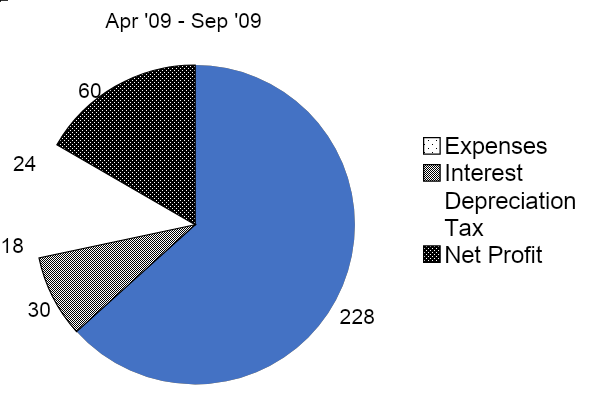
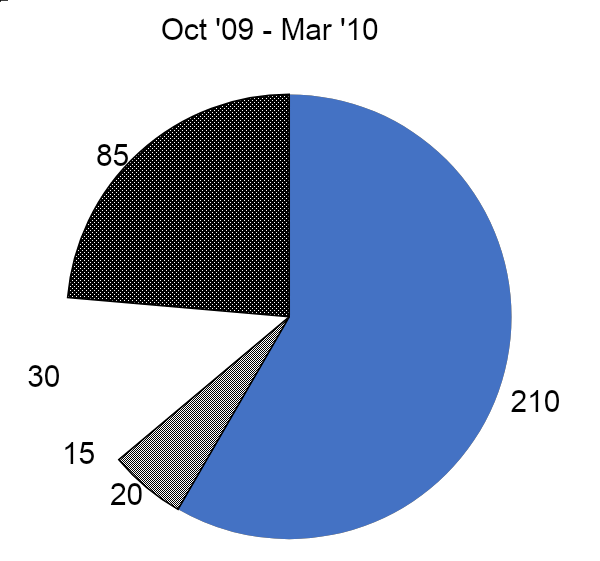
NOTE: The numbers given besides the sectors are the angle the sector makes at the center of the circle.
CAT previous year question 1. If the company pays equal amount of tax in the two half years, find the ratio of the income of the company in the first half year to that in the second half year.
1: 1
4: 5
5: 4
Cannot be determined
CAT previous year question 2. If expenses in the first half year is 60% of the total expenses of the year, which of the following ratios most closely represent the ratio of the Interest paid by the company in the two half years.
1: 1
3: 2
2: 1
3: 1
CAT previous year question 3. If Depreciation accounts for 4.66% of the total Income of the company over the entire financial year Apr ’09 to Mar ’10, Taxes account for what percent of the total Income of the company over the entire financial year
7%
7.33%
7.66%
8%
Additional directions for questions 4 to 5:
Income of the company in the first half year i.e. Apr ’09 – Sep ’09 is Rs. 120 cr and the income in the second half year i.e. Oct ’09 to Mar ’10 is Rs. 144 cr.
CAT previous year question 4. If profit percentage is Net Profit as a percentage of Expenses, find the profit percentage of for the entire year Apr ‘09 – Mar ‘10.
25%
27.5%
32.5%
33.75%
CAT previous year question 5. By what percentage is the Interest paid in the first half of the year more/less than the Interest paid in the second half of the year?
25% more
20% more
20% less
25% less
The numbers given are degree that the sector makes at the center. Since 360 degrees = 100%, to change degrees to percentages, we will have to divide by 3.6. One need not do this calculation unless absolutely must. Read through the explanation to see how one can avoid this.
Assume the income in first half year as 360x and in second half year as 360y.
CAT Previous Year Questions with Solutions
1. c
24x = 30y i.e.
![]() . This will be the ratio of the income in the two half years.
. This will be the ratio of the income in the two half years.
2. c
The ratio of the expenses in the two half years will be 60 : 40 i.e. 3 : 2. Thus,
![]()
The closest option is 2 : 1
3. b
Once could use (18x + 15y) = 4.66% (360x + 360y) to find the ratio of x and y and then proceed to find the ratio (24x + 30y)/(360x + 360y).
An easier way is to realise use Alligation to find the ratio x/y.
4.66% is
![]()
i.e. 14/3%.
This in degree terms is
![]()
= 16.8 degrees.
Thus, the weighted average of 18 and 15 is 16.8. Hence the weights are in the ratio 1.8 : 1.2 i.e. 3 : 2
Now we want to find the weighted average of 24 degrees and 30 degrees with weights being 3 : 2. The average is thus (72 + 60)/5 i.e. 132/5 degrees i.e. 26.4 degrees. In percentage terms this will be 264/36 i.e. 22/3 = 7.33%
For questions 4 & 5:
360x = 120 i.e. x = 1/3 and 360y = 144 i.e. y = 2/5.
4. d
Expense in first half = 228/3 = 76, Net profit in first half = 60/3 = 20
Expense in second half = 210 × 2/5 = 84, Net profit in second half = 85 × 2/5 = 34.
Thus, total profit = 54 and total expenses = 160. Thus, required percentage = 54/160 i.e. 33.75%
5. a
Interest paid in first half = 30/3 = 10. Interest paid in second half = 20 × 2/5 = 8.
Thus, required percentage 25% more.
Direction for Q6-Q10
A company conducted a survey among 75 households to know how many households own the electronic devices laptop, smart phones and tablets during the years 2015 and 2016.
In 2015 it was found that the number of households owning exactly one device, exactly two devices and exactly three devices are in the ratio 3 : 2 : 1
The households that own both laptop and tablet also own a smart phone.
In 2015, ten households owned both laptop and tablet.
In 2015 the number of households owning only laptop is the same as the number of households owing only smart phones, which is one less than the number of households owning all the three.
The number of households owning all the three devices in 2016 is three times of those that were owning all three devices in 2015.
The number of households owning exactly two devices is decreased by five and the number of households owning exactly one device remained the same.
In all it was found that none discarded any of the products already owned by them and no one purchased more than one new electronic device mentioned.
In 2016, the total number of households owning tablets increased by 50% and that owning laptop increased by 60% as compared to 2015.
Each household owning only smart phone in 2015 purchased tablets.
CAT previous year question 6. What was the number of households owning laptops or tablets in 2015?
A. 48 B. 50 C. 51 D. 54
Ans: C
CAT previous year question 7. What is the increase/decrease in the number of households owning smart phone, from 2015 to 2016?
A. 18 B. 10 C. 11 D. 17
Ans: D
CAT previous year question 8. What is the increase in the number of households owning only smart phones?
A. 1 B. 2 C. 3 D. 7
Ans: B
CAT previous year question 9. In which year was the difference in the number of households owning only laptop and smart phones, and the number of households owning tablet and smart phone higher? [TITA]
Ans: 2016.
CAT previous year question 10. What is the number of households that purchased smart phone in 2016, as their second device?
A. 4 B. 8 C. 11 D. 6
Ans: D
CAT sample Paper with Solution (Q6-Q10):
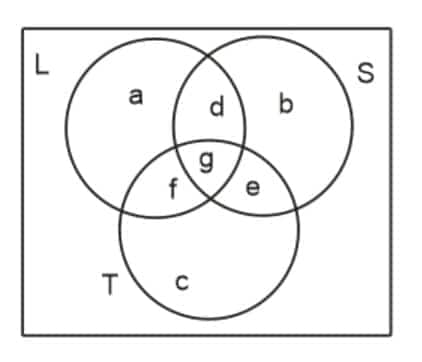
from (2) and (3), there is no one who owned laptop and tablet only and ten households own all the three. (∴ g = 10)
From (1), exactly one (a + b + c) = 30 and exactly two (d + e + f) = 20. Hence, n = 15.
From (4), a = b = (g – 1) = 9.
Hence, c = 12 Since f = 0, d + e = 20.
If e = k, then d = 20 – k
From (8), the number of households owning tablet must be an even number since f = 0, c = 12 and g = 10, e should also be even.
Let us say e = 2k, then d = 20 – 2k [from (8)], the number of households owning laptops increased by 60%. Hence it should be a multiple of 5 in 2015.
Thus, the conditions that the number of households that own laptop should be a multiple of 5 and the number of households owning tablets is an even number is possible only when k 2 or 7. If k = 2, the value for 2015 would be as follows.
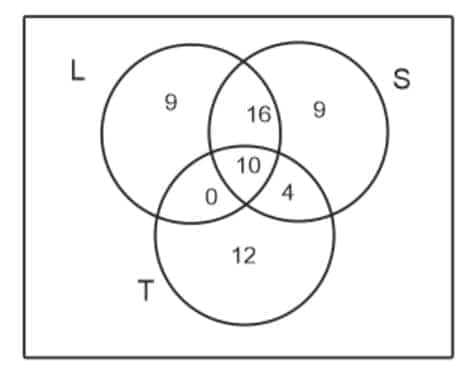
Families without any device will be 15, so total of tablet will be 26
From (5), (6) and (7) for 2016 g = 30, exactly one (a + b + c) = 30 and exactly two (d + e + f) = 15.
Hence, n = 0.
It is given that no one purchased more than one device. Hence, the entire 20 i.e., exactly two of 2015 shifted to g in 2016. From (a), all those who owned only smart phone (9) of 2015 purchased tablets. Hence, ‘e’ for 2016 is atleast 9. Hence ‘d’ for 2016 should be atleast 6, comes from a of 2015. But the number of households owning laptop should be 160% of 35 i.e., 56. It means 17 should be added from a, which is not possible. Thus k cannot be 2. k must be 7.
Families without any device will be 15, so total of tablet will be 36
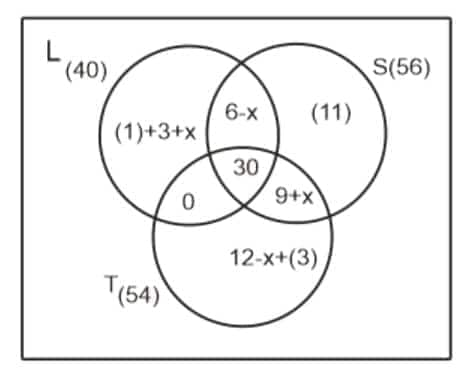
2016
Arrow indicates movements of devices towards house hold
The maximum value x can take is 6 (because 6-x cannot be negative)
Ans 6. The number of people owning laptops or tablets = 75 – (9 + 15) = 51.
Ans 7. The increase/decrease in the number of smart phone owners is 17.
Ans 8. The increase in the households that own only smart phones is 2.
Ans 9. Only laptop and smart phone ~ tablet and smart phone in 2015 = 24 – 6 = 18 In 2016 = 39 + x – 6 + x = 33 + 2x. ⇒ minimum = 33 maximum = 45 it is definitely higher in 2016. Ans: (2016)
Ans 10. From the venn diagram, 6 – x + x = 6 ∴ 6 households.
CAT Mock Test Part-C (VARC) focuses on Verbal Ability and Reading Comprehension, a key section of the CAT exam. It tests comprehension, grammar, vocabulary, and critical reasoning skills. Practising this section through mock tests helps improve reading speed, accuracy, and interpretation of complex passages.
Reading comprehension
Some people shy away from travelling alone, a few embrace it. So, what is it that makes it an attractive option? What are the advantages of going it alone? Well first things first, travelling solo can be very liberating. The itinerary you set and all the decisions you make are yours and yours alone. You don't need to worry about any other person or group. In other words, there's no need to compromise, there are no arguments, and no need to second-guess what other people want or need. Actually, you can be completely selfish. Travelling alone is also a great confidence builder. Yes, at times it can feel a bit lonely, but that is just one of many problems you will have to solve yourself, along with making your own arrangements, and setting your own goals.
Have you noticed that when you’re on your own, people are more willing to start a conversation with you? You're more likely to take the initiative as well, and before you know it, up pops an invitation for a meal, a side trip, a stay at someone’s home. For some odd reason people keep a slight distance from couples and groups, probably because they seem so self-contained and exclusive. Whereas the lone traveler looks ready to connect with their fellow human beings, and more likely to engage in pleasant conversation and simple exchanges about their travels. Putting it simply, lone travelers look interesting.
Here are two more exciting reasons why you should consider travelling solo: You will find you learn language faster when you don’t have someone else talking to you in your own language all the time. It’s funny, but we interact, are forced to interact much more frequently when we travel alone in a country that doesn’t speak our native tongue. If that doesn't convince you, there is the chance for adventure and even romance. When you’re on your own you’re free to meet someone who might turn out to be very important in your life. The most important factor to consider in your decision to make a trip alone is your own sense of independence. If you find that you have little tolerance for the idiosyncrasies of others, or you don't get how group dynamics work, you might be happier travelling alone. Of course, there may be things holding you back: Fear of the unknown, or maybe you have a spouse, relative, or friend who may be upset by your decision to take off by yourself, you will have to convince them of the value of travelling alone and allay any fears they might have, but with the technology at our fingertips, you can include them in the adventure.
CAT previous year question 1: According to the passage, what kind of people likes to travel alone?
Who is not well versed in communicating with others.
Who cannot adjust with the behavior and thoughts of other people.
Who is introvert.
Who doesn’t like to share their things with others.
All of the above
Ans: (b)
Explanation- Refer the 3rd paragraph
CAT previous year question 2: What is/are the demerits of travelling alone?
We need to solve the problems with ourselves.
We need to be dependent on unknown people for various things
Sometimes we can feel lonely.
Both (b) and (c)
All of the above
Ans: (c)
Explanation- refer the last lines of first para of the passage.
CAT previous year question 3: What are the things that restrict us to travel alone?
Relatives or spouse not allowing to travel alone.
The fear of unknown people might restrict us.
Not finding a reason to travel alone.
Only (i)
Only (ii)
Both (i) and (ii)
Both (ii) and (iii)
All are correct
Ans: (c)
Explanation- Refer the last para of the passage
CAT previous year question 4: What is/are the exhilarating reasons of travelling alone?
You need not to be dependent on others for any sort of work.
You will get to learn the others language.
By travelling alone we are free to know a person that might become a special part of our life.
You are free to do anything at any time while travelling alone.
Both (c) and (d)
Ans: (e)
Explanation- Refer the first few lines of 3rd para.
CAT previous year question 5: What are the advantages of travelling alone?
Make our connections strong with other people the journey.
We can selfishly make our own decisions.
Great confidence builder.
Only (i)
Only (ii)
Both (i) and (ii)
Both (ii) and (iii)
All are correct
Ans: (d)
Explanation- both sentences (ii) and (iii) are correct. Refer the first para.
CAT previous year question 6: Choose the most appropriate title of the passage.
Merits and demerits of travelling alone.
Travelling alone
Is travelling alone right?
Travelling alone brings independence
Technology at our finger tips
Ans: (b)
Explanation- “Travelling alone” is the appropriate title of the passage as the whole passage revolves around this theme.
Error Detection in the CAT exam tests a candidate’s grasp of grammar, sentence structure, and usage. It involves identifying incorrect parts of a sentence. Mastery of this skill helps improve accuracy in the Verbal Ability section and boosts the overall score.
CAT previous year question 7: Parliament made it clear that (a)/ Delhi was an UT and there was no doubt about it (b)/ and the city government was empowered to (c)/ take care of daily utilities of the capital. (d)/ No error (e)
Ans. (b): Replace ‘an’ with ‘a’
CAT previous year question 8: Delhi government cannot have (a)/ “exclusive” executive powers as it would be (b)/ against national interests, (c) / the Centre told the Supreme Court. (d) / No error (e)
Ans.(a) Use Article THE before Delhi.
CAT previous year question 9: A gang of burglars allegedly (a)/ made away with a luxury vehicle, (b)/ a licensed revolver and Rs. 10 lakh from a car showroom (c)/ in west delhi’s Kirti Nagar (d)/ No error (e)
Ans.(e) No error
CAT previous year question 10: From a careful examination of the witness (a)/ and documentary evidence, it is evident that (b)/ the accident had been occurred (c)/ due to rash and negligent driving of the offending vehicle. (d)/ No error (e)
Ans. (c) Delete ‘been’
To excel in CAT mock tests, a smart and strategic approach is essential. Candidates must balance speed and accuracy, understand question types, and manage time efficiently while learning from mistakes to improve with every attempt.
1. Scan and Prioritise
Start by quickly scanning the entire section to identify questions that seem easy or familiar. Attempt those first to secure quick and confident marks. This strategy helps build momentum and ensures that you don’t miss out on scoring opportunities due to difficult or time-consuming questions early on.
2. Time Allocation
Divide your total available time across sections and set mini time limits for groups of questions. For example, aim to finish every 10 questions within a fixed time. This discipline prevents spending too much time on any single question and allows you to attempt more within the overall time constraint.
3. Eliminate Options
When you're unsure of the correct answer, use logical reasoning to eliminate clearly incorrect choices. Narrowing down to two options increases the probability of a correct answer and helps you make informed guesses, especially in verbal and reasoning questions where absolute certainty can be difficult.
4. Avoid Guesswork
Since the CAT has negative marking for wrong answers, avoid random guessing. If you're completely unsure, it’s better to skip the question. Prioritise accuracy over attempting every question, as careless guesses can significantly impact your overall percentile.
5. Review Analysis
After each mock test, spend quality time reviewing your performance. Note the types of questions you got wrong, understand the logic behind the correct answers, and identify patterns in your mistakes. This post-test analysis is crucial for long-term improvement and refining your test-taking strategy.
I hope everyone would be able to take some takeaways from this practice questions session
See you tomorrow for Day 36
Till then, keep learning, keep practising.
Thank you!
All the best!
Frequently Asked Questions (FAQs)
To perform well in the CAT Reading Comprehension (RC) section, adopt a reading habit of reading various types of content, such as editorials, essays, and opinion pieces. Practice mock tests and previous year papers to enhance speed and comprehension. While trying RCs, read the passage thoroughly, locate key ideas, and apply elimination techniques for correctly answering questions.
Previous year questions give an idea about the pattern and difficulty of the exam, but they alone are not enough. CAT syllabus changes every year, and therefore it's important to solve more mock tests and sectional tests. Solving new problems on a regular basis will enhance problem-solving speed and adaptability.
The most effective sources for CAT RC preparation are The Hindu, The Economist, Aeon Essays, and Scientific American for varied reading practice. Books such as How to Read Better and Faster by Norman Lewis and computer-based mock tests are useful. Solving RC passages from previous CAT papers regularly increases question pattern familiarity.
CAT does not repeat questions directly, but the question types and concepts are the same. Logical Reasoning & Data Interpretation (LRDI) and Quantitative Aptitude (QA) sections can have problems based on known patterns from previous papers. Previous year questions practice assists in understanding trends and enhancing accuracy.
One of the Indian Institutes of Management (IIMs) prepares the CAT question paper in rotation. Each year, a particular IIM is entrusted with this task, which it formulates and oversees the entire exam process. Expert faculty prepares the questions in a manner that is fair and yet challenging.
CAT mock tests help candidates simulate the actual exam environment, assess their preparation level, identify strengths and weaknesses, and improve time management and accuracy.
It is recommended to attempt at least 25–40 full-length mock tests along with sectional tests to ensure thorough practice and performance tracking.
Ideally, mock tests should be started 4–6 months before the exam, with increasing frequency as the exam approaches. Begin with one test per week and increase to 2–3 per week later.
Post-test, review incorrect answers, understand the logic behind correct solutions, identify recurring mistakes, track time spent per question, and adjust your strategy accordingly.
Free CAT mock tests can offer valuable practice, especially in the early stages. However, paid mock series from reputed institutes often provide more realistic difficulty levels.
On Question asked by student community
Hello,
For a raw score of 56 in CAT 2025 Slot 3, your expected overall percentile is likely to be in the range of the 90th-95th percentile. The exact percentile can vary slightly on the final normalization process and the process and performance of all test-takers. In this article you'll find more about the CAT result.
I hope it will clear your query!!
Hello,
With a projected CAT percentile of 87% but not clearing sectional cutoffs, your chances at top IIMs are limited because they require both overall percentile and sectional minimums. However, you still have a good shot at other reputed management institutes and non-IIM B-schools. Consider colleges like NMIMS, SPJIMR, IMT, TAPMI, Great Lakes, and other well-ranked private or state-level B-schools that accept CAT scores and weigh your profile holistically. Your academic record, BSc in Animation with 80%, and 5 years of work experience at Ubisoft India are strong points and may help in institutes that value work experience in their selection process. Also, explore institutes that accept XAT, MAT, or CMAT, where your profile can be competitive.
Hope this helps you.
Good Morning,
NIT Rourkela CAT cutoff range is between 70-85 percentiles for the general category. 70 is the minimum percentile needed to apply, and 85 is the highest percentile. However, the maximum percentile depends on the particular year competition. It can be changed.
Thank You.
If you filled the UGC NET form under EWS but you don’t have a valid EWS certificate, then forget using the EWS category. They won’t accept it. You’ll automatically be treated as General category during document verification.
And no, this won’t make your form “invalid” or “illegal.” It just means you won’t get the EWS benefit.
So yes — you can still go for General category posts and Professor recruitment. Just don’t try to submit a fake/invalid certificate; that will get you disqualified.
Hello,
If your CAT admit card shows your surname first followed by your first name as entered in the form, it is correct. You do not need to worry about this format as long as it matches the details you provided. Ensure all other information on the admit card is accurate and carry it to the exam along with the required identification documents.
Hope this helps you.
Ranked among top 10 B-Schools in India by multiple publications | Top Recruiters-Google, MicKinsey, Amazon, BCG & many more.
Globally Recognized by AACSB (US) & AMBA (UK) | 17.8 LPA Avg. CTC for PGPM 2025
IBSAT 2025-Your gateway to MBA/PGPM @ IBS Hyderabad and 8 other IBS campuses | Scholarships worth 10 CR
AACSB Accredited | Highest CTC: 22 LPA | Last Date: 31st December 2025
Among top 6% B-Schools globally to be accredited by AACSB | 7000+ Alumni Network
Top 30 Private B-Schools Nationally and Top 3 in Gujarat | Highest CTC- 20 LPA | Average CTC- 8.4 LPA | 40% Pre-Placement Offers | 670+ Recruiters